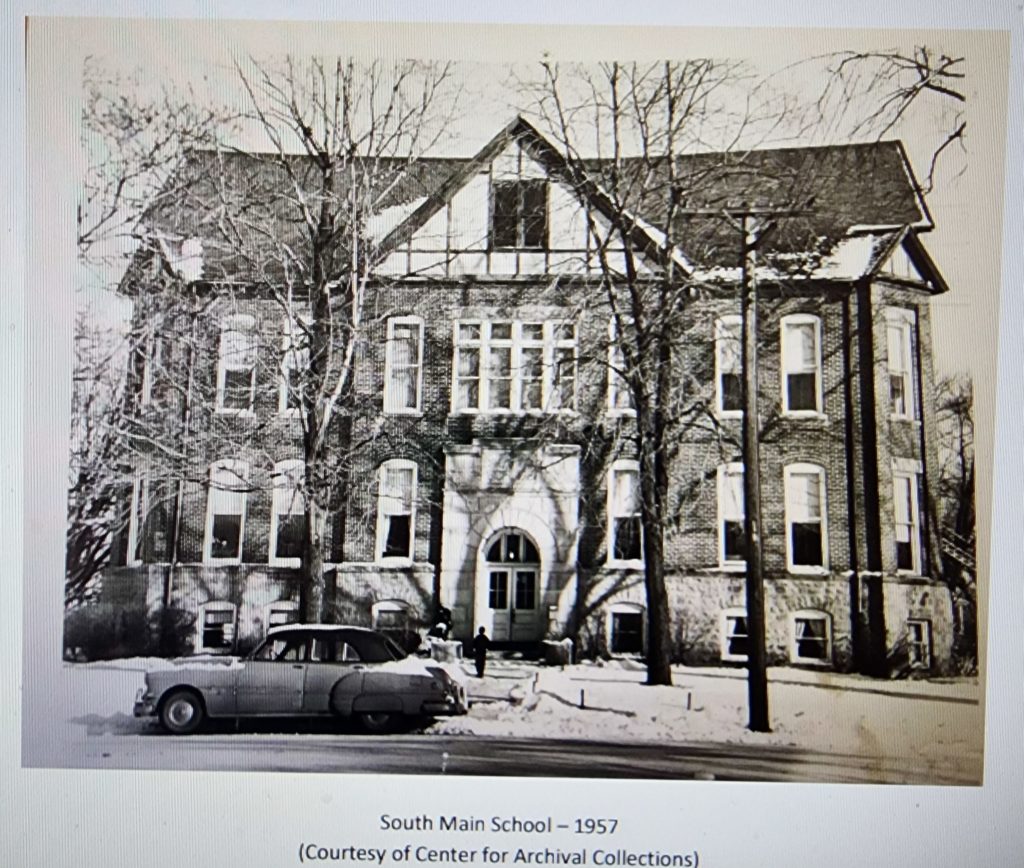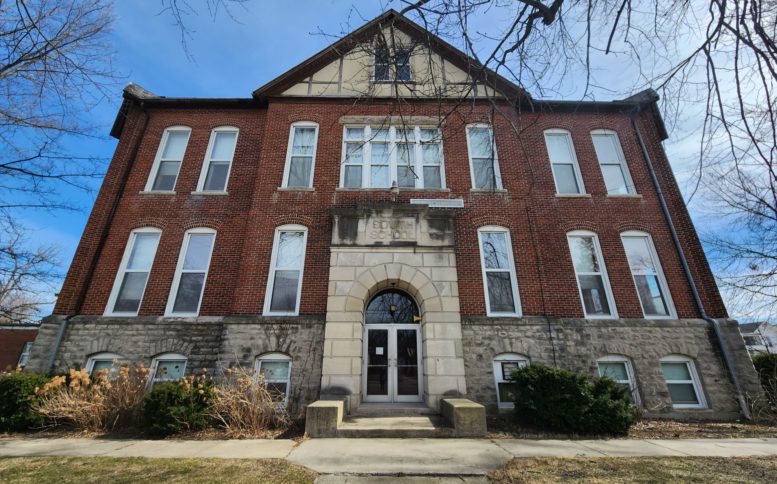The old South Main School has been selected as Bowling Green’s historic building of the month for May by the city’s Historic Preservation Commission.
In June 1889, the Bowling Green Board of Education awarded a contract to build South School, later South Main School, to the firm of Duncomb and Brown, on a bid of $8,480 (about $272,150 in current dollars). It was the third large schoolhouse in the growing city. The land was purchased after the Board of Education announced it would initiate proceedings to condemn existing structures on the property. The four-classroom school opened in 1890.
South Main School, at 437 S. Main St., was built in the Tudor Revival style, characterized by its half-timbered gables, steeply sloped roof, and imposing arched entry door. Five classrooms were added in this same style in 1927.
In 1928, the first elementary Parent-Teachers Association of Bowling Green was organized at South School, and the first elementary school cafeteria in Bowling Green was opened there in 1929. During the last major remodeling, in 1958, a gymnasium was added and the lavatories were improved. The cost was $60,000 (about $624,580 today).
On her retirement in 1960, Bess McClish, principal and sixth-grade teacher at South Main School since 1927, told Connie Barton of the Sentinel-Tribune: “When I took over, we had six teachers here, then seven, then nine. Since the new buildings have been erected, we are back to six teachers.”
In the Center for Archival Collections at BGSU’s Jerome Library there are two files of photographs, newspaper clippings, letters, and cards celebrating Miss McClish’s four decades at the school. Letters from all over the United States and as far away as Guam reveal a close-knit school community and mutual affection between Ms. McClish and the generations of students who passed through the halls of her school.
Letter writers remembered being disciplined years or even decades earlier for infractions like shooting “baby sized sling shots” or “eating jelly beans on the sly.” Others recalled academic successes, assemblies, and performances. Robert Garrett remembered gratefully: “Besides learning the difference between the subject and predicate and the numerator and denominator, we had many memorable times.” And Moses Lane wrote: “I suppose you must have felt I was more interested in when Mr. Fluhart would ring the recess bell than in what was being discussed in class.” He assured his former teacher that she had inspired him to change his ways and become a successful college graduate.
One notable former South Main student who sent a card was Dorothy Uber Bryan, the artist and philanthropist, who wrote: “Dear Miss McClish, What a grand feeling it must be, to have completed 42 productive years in the field of teaching. As a former student I want to express my appreciation for the many things you did for me and for the memories of many happy days. Sincerely, Dorothy Uber Bryan.”
The Dorothy Uber Bryan Gallery in BGSU’s Fine Arts Center is named for her, and Bryan Recital Hall in the College of Musical Arts honors her and her husband, banker and philanthropist Ashel Bryan.

In 2005 the school was closed due to declining enrollment and its deteriorating physical condition. The building had plumbing and electrical problems, was not handicapped accessible, and had inadequate storage, parking, and drop-off and playground space. Superintendent Hugh Caumartin estimated the district would save approximately half a million dollars annually in staff salaries and operating costs. The 130 students, over a third of whom did not live in the vicinity of the school but chose it for small class sizes or convenience, were reassigned to Kenwood and Crim elementary schools.
When the school board voted to close South Main School, many citizens expressed their unhappiness with the decision. The late John Hartman, a professor of journalism and former board member, said: “This educational heritage of our community is something to be proud of and to build upon, not to tear down or abandon to the wrecking ball or some other less noble use than educating elementary students.”
In the same year, the Board of Education leased the building to the Arts Council Lake Erie West, whose Executive Director Martin Nagy held open houses to get public input on best uses for the old school.
Soon the “South Main Common Space” housed the Jack & Jill Child Care Center, the Hiryuu School of Martial Arts, a dance and healing studio called the Radiance Center for the Healing Arts, an art gallery, and several artists’ studios. The Common Space also hosted performances such as one by the local Irish music ensemble Toraigh, led by Bob Midden.
In late May 2011 the school board announced that South Main would be sold at auction on June 24, meaning that Common Space tenants had to move out with only a few weeks’ notice. Tabitha Wilkens, the owner of the childcare center, said it was impossible to find a new space in such a short time, and even if she found one, she would have to get a license and inspections for it.
Laura Shakti of the Radiance Center for the Healing Arts had found another location for her dance studio, but she would not have an office to meet privately with clients. Shakti noted that tenants had invested their own money and “sweat equity” to improve the space. Artist Mary Dennis had worked on developing the space for five years. She wrote that the Common Space was “a great way to both utilize an old building that otherwise might sit empty and at the same time support arts in the community.”
The building was purchased by David Rosten of Newport Beach, California. As early as 2009, Fringe Paranormal Investigations had begun to explore the school’s potential as a site for occult exploration. In 2017, after the owner had repaired some $75,000 worth of roof damage, Fringe Associates LLC, the business arm of Fringe Paranormal, leased and took over management of the building in order to open the space to public and private investigations of unexplained activity such as “phantom footsteps, strange noises, closing doors, and disembodied voices.”
In July 2022, Mr. Rosten asked Fringe Paranormal to vacate the building in anticipation of selling it. Additionally, the building had become practically unfit for occupancy, with further roof damage and no water service after pipes burst.
Mr. Rosten still hopes to find a tenant for the building. A now deactivated 2019 posting on the commercial property marketplace LoopNet stated that the facility as zoned could be used for churches, schools, social services agencies, governmental offices, a youth hostel, an extended care facility, a nursing home, a nursery school, or a home for the aged. The posting also noted that the owner had prepared a plan to use 6,500 of the school’s total 24,000 square feet as a hostel with a kitchen but noted that this “change of use” would require fire sprinklers throughout the building, at an estimated cost of $75,000. A LoopNet listing updated on April 5, 2023, identifies the old school as a “24,000 SF Specialty Building offered at $500,000.”
By choosing South Main School as Historic Building of the Month for May, the Historic Preservation Commission recognizes that this venerable structure fulfills several criteria for historic value as listed in the City’s Historic and Architectural Preservation Code. It possesses historic significance, is identified with persons who influenced society, exemplifies the cultural and social heritage of the city, embodies distinctive characteristics of an architectural type, and represents an established and familiar visual feature of its neighborhood and the city.
Would you like to nominate a historic building or site for recognition? You can do this through the City website at – https://www.bgohio.org/FormCenter/Planning-13/Historic-BuildingSite-Nomination-Form-83
You can learn more about the Historic Preservation Commission by attending their meetings (the 4th Tuesday of each month at 4:00 p.m.) or by visiting their webpage at https://www.bgohio.org/436/Historic-Preservation-Commission
(Written by Geoffrey C. Howes, Bowling Green Historic Preservation Commission)

